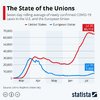PeterNSteinmetz
Ejection Handle Pulled
I thought this was a thoughtful article about a likely scenario with Covid-19.
“One outcome is now looking almost certain: This virus is never going away.
The coronavirus is simply too widespread and too transmissible. The most likely scenario, experts say, is that the pandemic ends at some point—because enough people have been either infected or vaccinated—but the virus continues to circulate in lower levels around the globe.”
https://www.theatlantic.com/health/archive/2020/08/coronavirus-will-never-go-away/614860/
“One outcome is now looking almost certain: This virus is never going away.
The coronavirus is simply too widespread and too transmissible. The most likely scenario, experts say, is that the pandemic ends at some point—because enough people have been either infected or vaccinated—but the virus continues to circulate in lower levels around the globe.”
https://www.theatlantic.com/health/archive/2020/08/coronavirus-will-never-go-away/614860/


